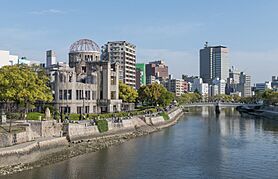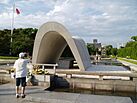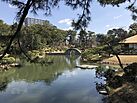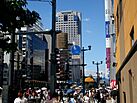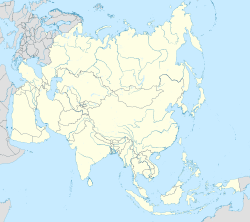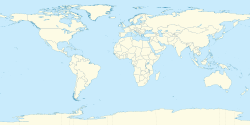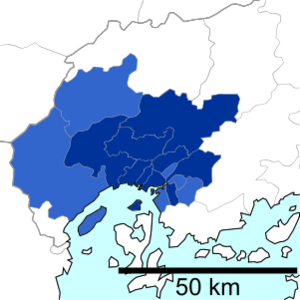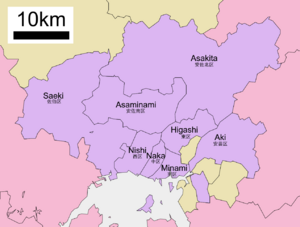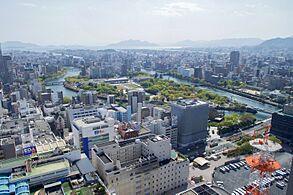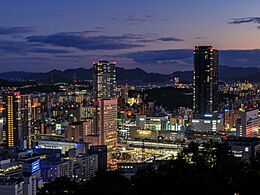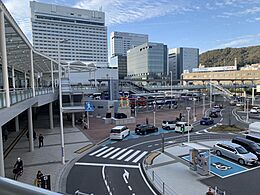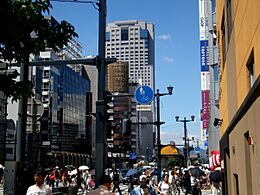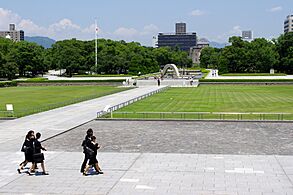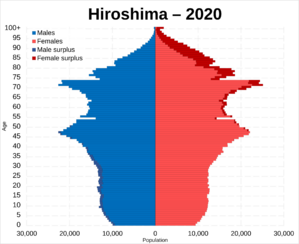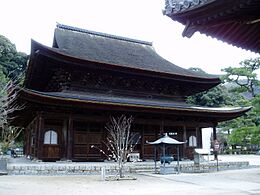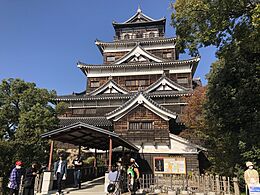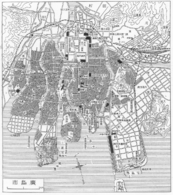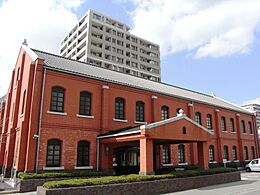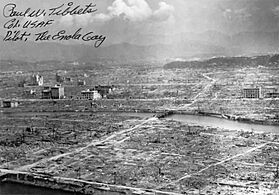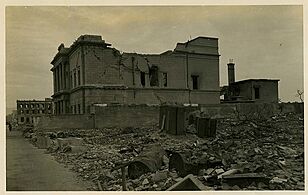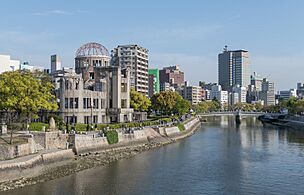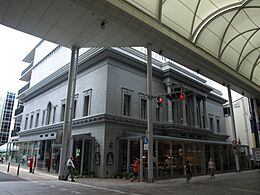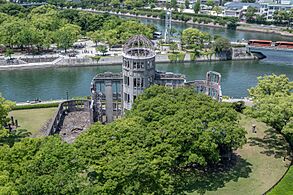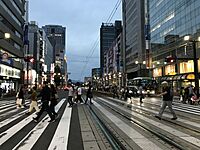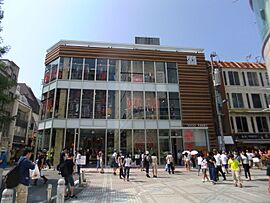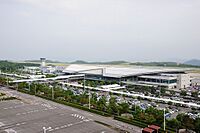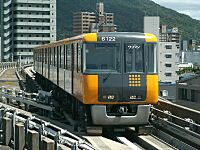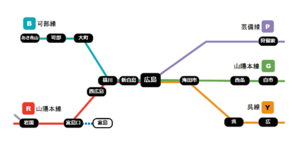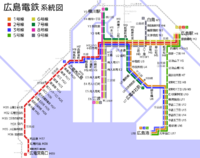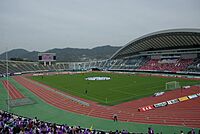Hiroshima facts for kids
Quick facts for kids
Hiroshima
広島市
|
|||
|---|---|---|---|
|
Clockwise from top: Hiroshima skyline within A-Bomb Dome, Hiroshima Peace Memorial Museum and Park, Hondōri(Downtown), Port of Hiroshima, Peace Message(Water lantern), Shukkei-en, Hiroshima Castle
|
|||
|
|||
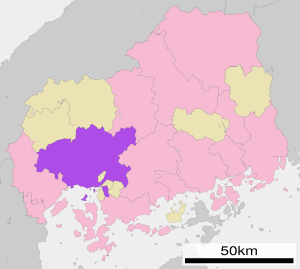
Location of Hiroshima in Hiroshima Prefecture
|
|||
| Country | |||
| Region | Chūgoku (San'yō) | ||
| Prefecture | Hiroshima Prefecture | ||
| Founded by | Mōri Terumoto | ||
| Area | |||
| • Designated city | 906.68 km2 (350.07 sq mi) | ||
| Population
(June 1, 2019)
|
|||
| • Designated city | 1,199,391 | ||
| • Density | 1,322.838/km2 (3,426.135/sq mi) | ||
| • Metro
(2015)
|
1,431,634 (10th) | ||
| Time zone | UTC+9 (Japan Standard Time) | ||
| Tree | Camphor Laurel | ||
| Flower | Oleander | ||
| Phone number | 082-245-2111 | ||
| Address | 1-6-34 Kokutaiji, Naka-ku, Hiroshima-shi 730-8586 |
||
| Hiroshima | |||||
|---|---|---|---|---|---|

|
|||||
| Japanese name | |||||
| Kyūjitai | 廣島 | ||||
| Shinjitai | 広島 | ||||
|
|||||
Hiroshima (広島市, Hiroshima-shi, /ˌhɪroʊˈ[unsupported input]mə/, also UK: /hɪˈrɒʃɪmə/, US: /hɪˈroʊʃɪmə/, [çiɾoɕima]) is a major city in Japan and the capital of Hiroshima Prefecture. As of 2019, about 1.2 million people live here. The city's mayor since 2011 has been Kazumi Matsui. Hiroshima is the second largest city area in the Chugoku Region of Japan.
Hiroshima started as a castle town in 1589 on the Ōta River delta. After the Meiji Restoration in 1868, it quickly grew into a big city and industrial center. In 1889, Hiroshima officially became a city. It was an important military hub during the imperial era, playing a big role in wars like the First Sino-Japanese War and Russo-Japanese War.
Sadly, Hiroshima was the first city ever hit by a nuclear weapon. This happened on August 6, 1945, during World War II. At 8:15 a.m., the United States dropped the atomic bomb "Little Boy" on the city. Most of Hiroshima was destroyed. By the end of that year, between 90,000 and 166,000 people had died from the blast and its effects. The Hiroshima Peace Memorial (a UNESCO World Heritage Site) stands today as a reminder of the bombing.
Since being rebuilt after the war, Hiroshima has become the largest city in the Chūgoku region of western Honshu. It is a symbol of peace and hope.
Contents
- Exploring Hiroshima's Location and Climate
- A Look at Hiroshima's Past
- Connecting with the World: International Relations
- Hiroshima's Economy and Infrastructure
- News and Media in Hiroshima
- Learning in Hiroshima: Education
- Famous People from Hiroshima
- Getting Around Hiroshima: Transportation
- Hiroshima's Culture and Traditions
- Sports in Hiroshima
- Visiting Hiroshima: Tourism
- Images for kids
- See also
Exploring Hiroshima's Location and Climate
Where is Hiroshima Located?
Hiroshima is located on the Ōta River delta, right on Hiroshima Bay. It faces the Seto Inland Sea to the south. The river splits into six channels, creating several small islands within the city.
What is Hiroshima's Weather Like?
Hiroshima has a humid subtropical climate. This means it has cool to mild winters and hot, humid summers. August is usually the warmest month. It rains throughout the year, but winter is the driest season. The most rain falls in June and July.
| Climate data for Hiroshima (1991–2020 normals, extremes 1879–present) | |||||||||||||
|---|---|---|---|---|---|---|---|---|---|---|---|---|---|
| Month | Jan | Feb | Mar | Apr | May | Jun | Jul | Aug | Sep | Oct | Nov | Dec | Year |
| Record high °C (°F) | 18.8 (65.8) |
21.5 (70.7) |
23.7 (74.7) |
29.0 (84.2) |
31.5 (88.7) |
34.4 (93.9) |
38.7 (101.7) |
38.1 (100.6) |
37.4 (99.3) |
31.4 (88.5) |
26.3 (79.3) |
22.3 (72.1) |
38.7 (101.7) |
| Mean daily maximum °C (°F) | 9.9 (49.8) |
10.9 (51.6) |
14.5 (58.1) |
19.8 (67.6) |
24.4 (75.9) |
27.2 (81.0) |
30.9 (87.6) |
32.8 (91.0) |
29.1 (84.4) |
23.7 (74.7) |
17.7 (63.9) |
12.1 (53.8) |
21.1 (70.0) |
| Daily mean °C (°F) | 5.4 (41.7) |
6.2 (43.2) |
9.5 (49.1) |
14.8 (58.6) |
19.6 (67.3) |
23.2 (73.8) |
27.2 (81.0) |
28.5 (83.3) |
24.7 (76.5) |
18.8 (65.8) |
12.9 (55.2) |
7.5 (45.5) |
16.5 (61.7) |
| Mean daily minimum °C (°F) | 1.6 (34.9) |
2.2 (36.0) |
5.1 (41.2) |
10.1 (50.2) |
15.1 (59.2) |
19.8 (67.6) |
24.1 (75.4) |
25.1 (77.2) |
21.1 (70.0) |
14.9 (58.8) |
8.9 (48.0) |
3.9 (39.0) |
12.7 (54.9) |
| Record low °C (°F) | −8.5 (16.7) |
−8.3 (17.1) |
−7.2 (19.0) |
−1.4 (29.5) |
1.8 (35.2) |
6.6 (43.9) |
14.1 (57.4) |
13.7 (56.7) |
8.6 (47.5) |
1.5 (34.7) |
−2.6 (27.3) |
−8.6 (16.5) |
−8.6 (16.5) |
| Average precipitation mm (inches) | 46.2 (1.82) |
64.0 (2.52) |
118.3 (4.66) |
141.0 (5.55) |
169.8 (6.69) |
226.5 (8.92) |
279.8 (11.02) |
131.4 (5.17) |
162.7 (6.41) |
109.2 (4.30) |
69.3 (2.73) |
54.0 (2.13) |
1,572.2 (61.90) |
| Average snowfall cm (inches) | 3 (1.2) |
3 (1.2) |
0 (0) |
0 (0) |
0 (0) |
0 (0) |
0 (0) |
0 (0) |
0 (0) |
0 (0) |
0 (0) |
2 (0.8) |
8 (3.1) |
| Average precipitation days (≥ 0.5 mm) | 6.8 | 8.3 | 10.6 | 9.9 | 9.7 | 11.9 | 11.6 | 8.6 | 9.6 | 7.1 | 6.9 | 7.6 | 108.6 |
| Average relative humidity (%) | 66 | 65 | 62 | 61 | 63 | 71 | 73 | 69 | 68 | 66 | 67 | 68 | 67 |
| Mean monthly sunshine hours | 138.6 | 140.1 | 176.7 | 191.9 | 210.8 | 154.6 | 173.4 | 207.3 | 167.3 | 178.6 | 153.3 | 140.6 | 2,033.1 |
| Source: Japan Meteorological Agency | |||||||||||||
How Hiroshima is Divided: Wards
Hiroshima is split into eight main areas called "wards" (ku). Each ward has its own unique features. The central ward, Naka-ku, is where the city's main government offices are.
Views of Hiroshima City
- Gallery
-
Hiroshima City CBD (2016)
How Many People Live in Hiroshima?
| Historical population | ||
|---|---|---|
| Year | Pop. | ±% |
| 1920 | 160,510 | — |
| 1925 | 195,731 | +21.9% |
| 1930 | 270,417 | +38.2% |
| 1935 | 310,118 | +14.7% |
| 1940 | 343,968 | +10.9% |
| 1945 | 137,197 | −60.1% |
| 1950 | 285,712 | +108.2% |
| 1955 | 357,287 | +25.1% |
| 1960 | 540,972 | +51.4% |
| 1965 | 665,289 | +23.0% |
| 1970 | 798,540 | +20.0% |
| 1975 | 862,611 | +8.0% |
| 1980 | 992,736 | +15.1% |
| 1985 | 1,044,118 | +5.2% |
| 1990 | 1,085,705 | +4.0% |
| 1995 | 1,105,203 | +1.8% |
| 2000 | 1,134,134 | +2.6% |
| 2005 | 1,151,888 | +1.6% |
| 2010 | 1,174,209 | +1.9% |
| 2015 | 1,186,655 | +1.1% |
| 2020 | 1,199,186 | +1.1% |
In 2017, Hiroshima had about 1,195,327 people. The city covers an area of about 905 square kilometers. This means there are about 1321 people living in each square kilometer. As of 2023, the population is 1,183,696.
Before World War II, Hiroshima's population grew to 360,000 people. It reached its highest point of 419,182 in 1942. After the atomic bombing in 1945, the population dropped to 137,197. But by 1955, the city's population was back to its pre-war levels.
A Look at Hiroshima's Past
Early Beginnings of Hiroshima
The area where Hiroshima is now was once a small fishing village. It was located along the coast of Hiroshima Bay. From the 12th century, this village became quite successful. It traded a lot with other parts of Japan.
From Castle Town to Modern City (1589–1939)
Hiroshima was officially founded in 1589. A powerful warlord named Mōri Terumoto built it on the delta of the Seto Inland Sea. He quickly built Hiroshima Castle and moved in by 1593. The name Hiroshima means "wide island" in Japanese.
After a big battle, Mōri Terumoto lost control of Hiroshima. The city was then ruled by the Asano clan from 1619 until 1871. In 1871, Hiroshima became the capital of Hiroshima Prefecture.
During the late 1800s, Hiroshima grew into a major city. Japan's economy was changing from farming to industry. A new harbor, Ujina Harbor, was built in the 1880s. This made Hiroshima an important port city.
In 1894, the San'yō Railway reached Hiroshima. A special rail line was built to the harbor for military transport during the First Sino-Japanese War. The Japanese government even moved to Hiroshima temporarily during this war. New factories, like cotton mills, also opened.
More industries grew during the Russo-Japanese War in 1904. This was because the city needed to produce military supplies. A building called the Hiroshima Prefectural Industrial Promotion Hall was built in 1915 to show new products. Today, this building is known as the A-Bomb Dome. It is a World Heritage Site and is kept as it was after the bombing.
During World War I, Hiroshima was a key military center. About 500 German prisoners of war were held on Ninoshima Island in Hiroshima Bay. The city continued to grow after the war.
- Gallery
World War II and the Atomic Bombing (1939–1945)
During World War II, Hiroshima was a very important military city for Japan. It had army headquarters and large storage areas for military supplies. Other Japanese cities were heavily bombed during the war, but Hiroshima was not. This made people think it might be a target. To prepare, children aged 11–14 helped clear houses to create firebreaks.
On Monday, August 6, 1945, at 8:15 a.m., an American plane called the Enola Gay dropped the atomic bomb "Little Boy" on Hiroshima. At least 70,000 people died instantly. This included thousands of Korean forced laborers. Less than 10% of those who died were military personnel. By the end of the year, the total number of deaths from injuries and radiation reached 90,000–140,000. About 70% of the city's buildings were destroyed.
After the bombing, information about the attack was kept secret by US military censors during the occupation of Japan. Films and casualty numbers were not released to the public until 1951. The book Hiroshima by John Hersey, which told the stories of six survivors, was very impactful in the US but was banned in Japan for a time.
The Oleander flower is the official flower of Hiroshima. It was the first flower to bloom again after the atomic bomb explosion in 1945.
- Gallery
Rebuilding Hiroshima: Postwar Period (1945–Present)

Soon after the bombing, on September 17, 1945, a strong typhoon hit Hiroshima. This caused even more damage and led to over 3,000 deaths and injuries in the prefecture. Many bridges, roads, and railroads were destroyed.
From 1945 to 1952, British Commonwealth forces occupied Hiroshima. The city was rebuilt with help from the Japanese government. The Hiroshima Peace Memorial City Construction Law was passed in 1949. This law provided money and land for the city's reconstruction.
In 1949, the design for the Hiroshima Peace Memorial Park was chosen. The Genbaku Dome (Atomic Dome), the closest building to where the bomb exploded that was still standing, became part of this park. The Hiroshima Peace Memorial Museum opened in 1955. Hiroshima's historic castle was rebuilt in 1958. A unique Peace Pagoda made of steel was built in 1966.
In 1949, the Japanese parliament declared Hiroshima a City of Peace. The city's mayor, Shinzo Hamai, led this effort. Because of this, Hiroshima became a popular place for international meetings about peace and social issues. The Mayor of Hiroshima is now the president of Mayors for Peace. This group works to get rid of all nuclear weapons worldwide.
On May 27, 2016, Barack Obama became the first sitting United States president to visit Hiroshima since the atomic bombing. In May 2023, the 49th annual G7 summit was held in Hiroshima.
- Gallery
-
Atomic Bomb Dome by Jan Letzel and modern Hiroshima
Connecting with the World: International Relations
Sister Cities of Hiroshima
Hiroshima has six "sister cities" around the world. These cities have special friendly relationships with Hiroshima:
Within Japan, Hiroshima also has a similar special relationship with the city of Nagasaki.
Hiroshima's Economy and Infrastructure
Hiroshima is home to important companies like Mazda Motor Corporation. There are also many shipyards in the area, including those from Mitsubishi Heavy Industries, Kawasaki Heavy Industries, and Japan Marine United.
News and Media in Hiroshima
The main local newspaper in Hiroshima is the Chugoku Shimbun. It publishes both morning and evening editions. There are several television stations, including Hiroshima Home Television and Hiroshima Telecasting. Radio stations like Hiroshima FM also serve the city. NHK, Japan's public broadcaster, also has TV and radio services in Hiroshima.
Learning in Hiroshima: Education

Universities and Colleges
Hiroshima University was founded in 1949. It brought together eight different schools to create one large university. In 1972, most of Hiroshima University moved to a bigger campus in Higashihiroshima City. However, some parts, like the schools of medicine and dentistry, are still in Hiroshima City.
Other notable art schools include the Elisabeth University of Music and Actor's School Hiroshima.
Famous People from Hiroshima
- Reiji Okazaki (1930–1975), a molecular biologist who discovered "Okazaki fragments."
- Kumi Tanioka, a talented composer and pianist.
- Suzuka Nakamoto, a singer from the band Babymetal.
- Mana, a visual kei musician.
- Unicorn (Japanese band), a popular rock band.
- Perfume (Japanese band), a famous girl group.
Getting Around Hiroshima: Transportation
Flying to Hiroshima
Hiroshima Airport
Hiroshima is served by Hiroshima Airport (HIJ). It is about 50 kilometers east of the city. You can find regular flights to other Japanese cities like Tokyo and Sapporo. There are also international flights to places like China, Taiwan, and South Korea.
Trains and Trams in Hiroshima
High-Speed Rail
The San'yō Shinkansen (bullet train) connects Hiroshima to other major cities in Japan.
Local Trains
The JR West operates several local train lines in Hiroshima, part of the Hiroshima City Network. These include the San'yō Main Line and Kure Line.
Astram Line
The Astram Line is a modern transit system that helps people get around the city.
Trams (Streetcars)
Hiroshima is famous for its light rail system, known as Hiroden. It's sometimes called the "Moving Streetcar Museum." Streetcar service began in 1912. Even after the atomic bomb, service quickly restarted in some areas just three days later.
Today, streetcars still run through Hiroshima. Some, like streetcars 651 and 652, even survived the atomic blast! Hiroshima has more streetcars than any other city in Japan.
- Hiroden operates several lines, including the Hiroden Main Line and Hiroden Miyajima Line.
Roads and Highways
Hiroshima has a network of roads and expressways. The Hiroshima Expressway helps drivers move quickly through the city. Several national routes, like Japan National Route 2, also pass through Hiroshima.
Traveling by Sea
Port of Hiroshima
The Port of Hiroshima is an important seaport.
Ferry Services
You can take ferries from the Port of Hiroshima to other places. These include the Port of Kure and Port of Matsuyama. There are also ferries to nearby islands like Nino-shima Island.
Hiroshima's Culture and Traditions
Hiroshima has its own professional symphony orchestra. The city also has many museums. These include the Hiroshima Peace Memorial Museum and several art museums. The Hiroshima Museum of Art has a large collection of French art. The Hiroshima City Museum of Contemporary Art focuses on modern art.
Festivals and Events in Hiroshima
Hiroshima hosts several exciting festivals and events:
- Hiroshima Flower Festival: Held in May, this festival celebrates flowers and peace.
- Hiroshima International Film Festival: An annual film festival in November.
- Hiroshima Peace Memorial Ceremony: Held every year on August 6th at the Hiroshima Peace Memorial Park. This ceremony remembers the atomic bombing.
Delicious Food: Hiroshima's Cuisine
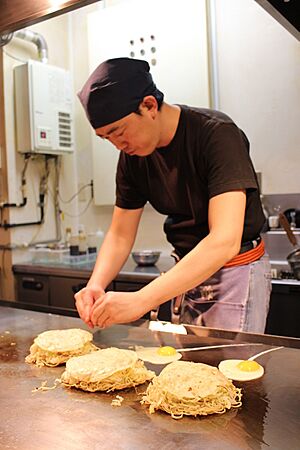
Hiroshima is famous for its unique style of okonomiyaki. This is a savory pancake cooked on a hot iron plate, often right in front of you! Unlike the Osaka version, the ingredients are layered, not mixed. Typical layers include egg, cabbage, bean sprouts, sliced pork, and noodles (like soba or udon). It's topped with more egg and a special okonomiyaki sauce. The amount of cabbage is usually much more than in the Osaka style.
Sports in Hiroshima
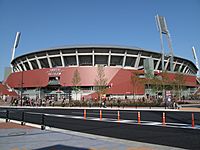
Hiroshima has several professional sports teams.
Football (Soccer)
The city's main football club is Sanfrecce Hiroshima. They play at the Edion Peace Wing Hiroshima. They have won the Japan Soccer League five times and the J.League three times.
Baseball
The Hiroshima Toyo Carp are the city's major baseball club. They play at the Mazda Zoom-Zoom Stadium Hiroshima. They have won the Central League many times and the Japan Series three times.
Other Sports Teams
- Hiroshima Dragonflies (basketball)
- Hiroshima Maple Reds (handball)
- JT Thunders (volleyball)
Hiroshima also hosted the 1994 Asian Games.
Visiting Hiroshima: Tourism
Hiroshima is a very popular place for tourists. In 2016, about 1.18 million foreign visitors came to the city. Many visitors come from the United States and Australia.
Popular Places to Visit
There are many popular tourist spots in and around Hiroshima:
- Hiroshima Peace Memorial Museum: Learn about the atomic bombing and its impact.
- The Atomic Bomb Dome: The preserved building that survived the atomic blast.
- Hiroshima Peace Memorial Park: A park dedicated to peace, with many monuments.
- Mazda Zoom-Zoom Stadium Hiroshima: Home of the Hiroshima Toyo Carp baseball team.
- Hiroshima Castle: A rebuilt historic castle with a museum.
- Shukkei-en: A beautiful traditional Japanese garden.
- Mitaki-dera Temple: A peaceful Buddhist temple.
- Hondōri: A busy shopping arcade in the city center.
- Hiroshima City Asa Zoological Park: A fun zoo for animal lovers.
- Hiroshima Botanical Garden: A lovely garden with many different plants.
A popular destination outside the city is Itsukushima Island, also known as Miyajima. It's a sacred island with many temples and shrines.
Images for kids
See also
 In Spanish: Hiroshima para niños
In Spanish: Hiroshima para niños


